Stand-up Paddling (SUP)
Standup paddle boarding (SUP) is a water sport born from surfing.
Stand up paddle boarders stand on boards that are floating on the water, and use a paddle to propel themselves through the water.
The sport was documented in a 2013 report that identified it as the outdoor sporting activity with the most first-time participants in the United States that year. Variations include flat water paddling, racing, surfing, whitewater SUP, and yoga.
SUP surfing is a variation of traditional surfing. Instead of lying prone on the surf board and paddling with arms to get out to the surf zone, SUP surfing allows the participant to stand on the board from the shore and paddle out to the surf zone using a SUP paddle.
The best way to move forward is to stand hip-width apart on the board with your knees slightly bent. The paddle should be held in the water perpendicular to the board so that you do not unintentionally steer while driving. Once in the surf zone, the rules for surfing still apply, you paddle and steer with the SUP paddle to catch a wave.
SUP Touring
In 2007 the concept of paddle boarding on flat-water began to take serious shape and a year later the first touring boards started to hit the market. This style of board differs from traditional surfing style SUPs in that it includes a displacement hull. The displacement hull allows the board to glide and track similar to a canoe or kayak. Many other features were soon offered, including deck rigging to carry gear. The fast design with more glide is an attractive option for those who plan to keep their adventures inland.
Tour paddle boarding has become a way for individuals to seek adventure, serenity, personal achievement and a deeper connection with nature.
Going into the Water

Don't lift the board straight off the ground, lift it up away from you onto the rail first, so it's standing up on the rail.
 Then you can grab the carry handle and lift it up.
Don't set the board on down too early, you want to make sure the fin behind you clears the sand.
Then you can grab the carry handle and lift it up.
Don't set the board on down too early, you want to make sure the fin behind you clears the sand.
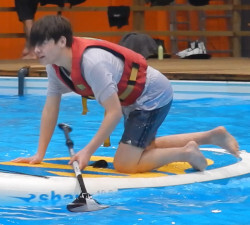 Put your knees on either side of the handle
so you're evenly balanced over the centre line of the board.
Then take a few strokes on your knees.
Put your knees on either side of the handle
so you're evenly balanced over the centre line of the board.
Then take a few strokes on your knees.
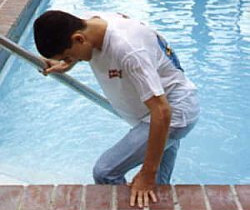
This can be exhausting at first.
Take a few breaks.
Stand up on your feet right where your knees were, keep the paddle in the water, look forward and start paddling.
You don't want to get stuck in a position where you're leaning forward or looking down at the water.
That's a very hard position to find your balance.
Put your paddle into the water, stand up straight, your chest forward,
look at the horizon at something stable, and then start paddling.
Falling in
It happens even to the best of paddlers when they just lose their balance. This can be a lot of fun. The good news is that the blue ocean around you makes for a pretty comfortable landing site.
On the other hand, if you try to make an emergency save and resist the temptation to fall, you could end up falling awkwardly onto the board and endure a much harder landing.
A common mistake is falling onto the board instead of falling into the water. A lot of beginners try to catch their fall like they do on land, in an attempt to keep their clothes dry. When they're going to fall they try to catch themselves and fall on their knees or fall out on their hands but that's a way to get hurt. Some people have broken their ribs, hurt their wrist, damaged their boards, or hurt their knees. The board is hard, the water is soft.
When you feel like you’re going to fall off the board, the best thing is to simply let it happen and go for a graceful dip. Besides, being able to cool off by just jumping off your board is one of the greatest benefits of stand up paddling, so look at falling in as part of the fun experience as opposed to a paddling failure.
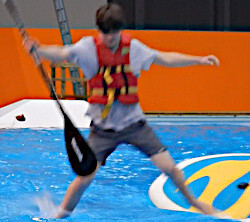
When you fall off, aim for the water, not the board. Relax, it's a watersport. Getting wet is part of the appeal.
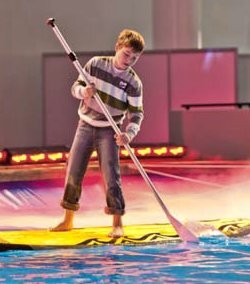
While dry, you might be nervous about getting your clothes wet.
Paddle Handling
A mistake beginners make is to hold the paddle too high or when they switch sides hold it at different heights on one side than on the other side. So ideally you want to hold the paddle pretty far apart,
Another common mistake is making the stroke too far to the side away from the board and holding the paddle diagonally away from the board which makes your board turn left or right. If you want your board to go forward, you want to hold your paddle straight down, and pull it straight back in a straight line.
If you lose your balance your paddle is like your walking stick. Keep it in the water and it gives you extra stability you can kind of lean on if you are losing your balance.
You don't want to put the paddle in close to your feet and then pull back behind you. This is wasted energy behind because you're pulling water up instead of propelling yourself forward. So ideally you want to plant the paddle nice in front of you, get the whole blade in the water, and pull it back.
Many beginners only use the tip of the blade, not use the whole blade, so that the paddle just slips through the water. You get a nice catch with your paddle when you fully plant it in the water and then pull on it. The whole blade should be underwater.
Stand Up Right
You find the right trim of the board when you stand near the handle. which is when the board will be flat on the surface of the water.
When you're too far forward, you might sink the nose or lift up the tail out of the water. The board is not flat on the water surface. If you're too far back, the tail will sink, it's less stable, and you're kind of dragging it through the water. so make sure you trim out the board by standing right in the center. Be mindful of any local hazards and where not to go. Also wind, especially offshore wind, can be very dangerous, so make sure you always Paddle upwind first, and then coming back will be easy. You don't want to go with the wind and then find out you can't make it back. Be aware of the weather and the wind and if that anything changes.
Outdoors
First of all you always want to make sure you wear your leash for safety. It connects you to the board, so when you fall off, the wind won't blow the board away. You can always get back to shore with your board.
If you're paddling for the first time especially, make sure you go somewhere where lifeguards are or other people that can help watch you. Don't go out by yourself, make sure someone knows where you're going.
Going back to the beach, step off carefully with one foot.
When you touch the bottom, step off with the other foot.
Lift the board up with the handle pointing away.
Carry the board out of the water like this.
Clothing
You can wear whatever you want for stand-up paddling, as long as you remember it is a watersport, you will get wet, and you better dress right for the climate and water temperature.
In cold climate a wetsuit under windbreaker clothes will be required. In hot weather any sportswear or casual clothes will do, whatever you like to wear in the water. If you enjoy swimming in clothes, this sport is for you.

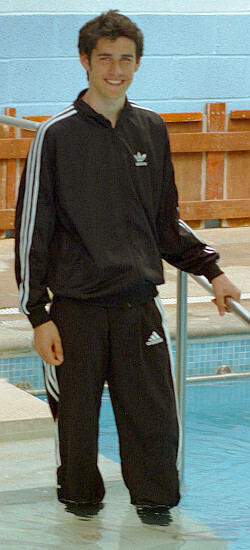
Summary
If you enjoy swimming in clothes, this sport is for you. Stand up paddling is a really safe fun sport, low-impact, it's great to improve your balance. This is probably one of the best sports you can do for staying healthy and happy, mentally and physically, so enjoy it, be safe, have fun.
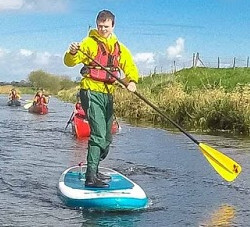
Remember: It's a watersport.
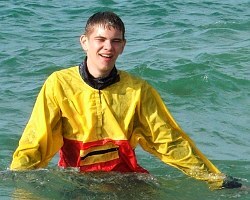 You will get wet often, clothes and all. Enjoy!
You will get wet often, clothes and all. Enjoy!